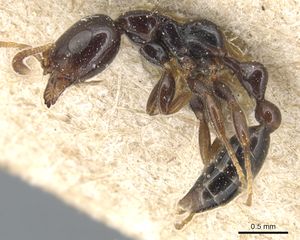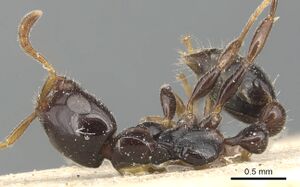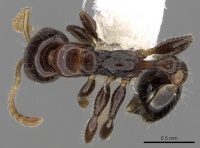Tetraponera crassiuscula
| Tetraponera crassiuscula | |
|---|---|

| |
| Scientific classification | |
| Kingdom: | Animalia |
| Phylum: | Arthropoda |
| Class: | Insecta |
| Order: | Hymenoptera |
| Family: | Formicidae |
| Subfamily: | Pseudomyrmecinae |
| Genus: | Tetraponera |
| Species: | T. crassiuscula |
| Binomial name | |
| Tetraponera crassiuscula (Emery, 1900) | |
A collection from Kepong, Malaysia (leg. Maschwitz) was made from twigs of Rhizophoraceae. A worker from Umas Umas, Borneo was taken “ex trunks, tops, recently felled trees, rainforest”.
Identification
A member of the Tetraponera allaborans species-group.
Ward (2001) - Tetraponera crassiuscula belongs to a group of closely related taxa, here termed the T. modesta-complex. Three morphotypes can be tentatively recognised: T. crassiuscula, a dark brown form with a short, broad petiole (worker PLI 0.60-0.68); Tetraponera modesta, a smaller, yellow or orange-brown species, with more slender petiole (PLI 0.45-0.59); and Tetraponera extenuata, similar to T. modesta but with relatively large, mostly black workers. Sympatric associations of at least two of the three forms are known from some localities (Bukit Timah, Singapore: T. extenuata and T. modesta; Pasoh Forest, Malaysia: T. crassiuscula, T. extenuata and T. modesta; Poring Spring, Malaysia: T. extenuata and T. modesta), suggesting that they represent good species. Not all collections can be easily assigned to one of these three taxa, however.
Keys including this Species
Distribution
T. crassiuscula is known from Thailand, peninsular Malaysia, Sumatra, and Borneo.
Latitudinal Distribution Pattern
Latitudinal Range: 8.95° to -1.466666667°.
| North Temperate |
North Subtropical |
Tropical | South Subtropical |
South Temperate |
- Source: AntMaps
Distribution based on Regional Taxon Lists
Indo-Australian Region: Borneo, Indonesia (type locality), Malaysia, Singapore.
Oriental Region: Thailand.
Distribution based on AntMaps
Distribution based on AntWeb specimens
Check data from AntWeb
Countries Occupied
| Number of countries occupied by this species based on AntWiki Regional Taxon Lists. In general, fewer countries occupied indicates a narrower range, while more countries indicates a more widespread species. |

|
Estimated Abundance
| Relative abundance based on number of AntMaps records per species (this species within the purple bar). Fewer records (to the left) indicates a less abundant/encountered species while more records (to the right) indicates more abundant/encountered species. |

|
Biology
Castes
Worker
Images from AntWeb
   
| |
| Syntype of Sima allaborans crassiuscula. Worker. Specimen code casent0904038. Photographer Will Ericson, uploaded by California Academy of Sciences. | Owned by MSNG, Genoa, Italy. |
Nomenclature
The following information is derived from Barry Bolton's Online Catalogue of the Ants of the World.
- crassiuscula. Sima allaborans subsp. crassiuscula Emery, 1900d: 677, fig. 6 (w.) INDONESIA (Sumatra). Combination in S. (Tetraponera): Viehmeyer, 1916a: 117; Emery, 1921f: 25; in Tetraponera: Crawley, 1924: 390; Chapman & Capco, 1951: 78. Raised to species: Ward, 2001: 611.
Unless otherwise noted the text for the remainder of this section is reported from the publication that includes the original description.
Description
Worker
Ward (2001) - HW 0.53-0.61, HL 0.66-0.73, LHT 0.45-0.52, CI 0.73-0.84, FCI 0.08-0.11, REL 0.36-0.40, REL2 0.46-0.50, SI 0.60-0.66, SI3 1.24-1.36, FI 0.40-0.43, PLI 0.60-0.68, PWI 0.46-0.54, PDI 1.14-1.26, LHT/HW 0.81-0.91, CSC 1-10, MSC 1-19.
Small species; median clypeal lobe narrow but moderately prominent, furnished with three blunt denticles; anterior margin of clypeal lobe slightly exceeding the reach of the anterolateral margins of the clypeus; profemur slender; lateral margins of pronotum soft-edged, convex in dorsal view, and corresponding to the maximum width of pronotum; mesopropodeal impression deep but somewhat short (from anterior to posterior ends), lacking metanotal plate; propodeum high and narrow, such that PDI > 1.12; petiole relatively short, with a prominent node (PL 0.38-0.46, PLISL 1.09-1.19; see also PLI and PWI values). Integument smooth and shiny, with scattered fine punctures (c. 0.01 mm diameter) and fine irregular lineations; lower malar area longitudinally carinate; weak carinulae variably developed (may be absent) on side of posterior mesosoma. Pilosity variable (MSC 1-19), but tending to be more common than in related taxa; some workers with four or more standing hairs (>0.05 mm in length) visible in profile on each of the following: dorsum of head, pronotum, mesonotum, petiole and postpetiole; such setae grading into shorter decumbent and appressed hairs; in other specimens standing pilosity much sparser (or abraded). Dark brown, with lighter brown petiole, postpetiole, pronotum and appendages; legs concolorous medium brown.
Type Material
Ward (2001) - Syntypes, 2 workers, D. Tolong, Sumatra, Indonesia (E. Modigliani) (Museo Civico di Storia Naturale, Genoa).
References
- Ward, P. S. 2001. Taxonomy, phylogeny and biogeography of the ant genus Tetraponera (Hymenoptera: Formicidae) in the Oriental and Australian regions. Invertebrate Taxonomy. 15:589-665. (page 611, Raised to species)
- Chapman, J. W.; Capco, S. R. 1951. Check list of the ants (Hymenoptera: Formicidae) of Asia. Monogr. Inst. Sci. Technol. Manila 1: 1-327 (page 78, Combination in Tetraponera)
- Crawley, W. C. 1924a. Ants from Sumatra, with biological notes by Edward Jacobson. Ann. Mag. Nat. Hist. 9(13): 380-409 (page 390, Combination in S. (Tetraponera))
- Emery, C. 1900d. Formiche raccolte da Elio Modigliani in Sumatra, Engano e Mentawei. [part]. Ann. Mus. Civ. Stor. Nat. 40[=(2(20): 689-720 (page 677, fig. 6 worker described)
- Emery, C. 1921c. Hymenoptera. Fam. Formicidae. Subfam. Myrmicinae. [part]. Genera Insectorum 174A:1-94 94: 1-94 + 7 (page 25, Combination in S. (Tetraponera))
- Kreider, J.J., Chen, T.W., Hartke, T.R., Buchori, D., Hidayat, P., Nazarreta, R., Scheu, S., Drescher, J. 2021. Rainforest conversion to monocultures favors generalist ants with large colonies. Ecosphere 12 (doi:10.1002/ecs2.3717).
- Viehmeyer, H. 1916a [1915]. Ameisen von Singapore. Beobachtet und gesammelt von H. Overbeck. Arch. Naturgesch. (A) 81(8): 108-168 (page 117, Combination in S. (Tetraponera))
- Wang, W.Y., Soh, E.J.Y., Yong, G.W.J., Wong, M.K.L., Benoit Guénard, Economo, E.P., Yamane, S. 2022. Remarkable diversity in a little red dot: a comprehensive checklist of known ant species in Singapore (Hymenoptera: Formicidae) with notes on ecology and taxonomy. Asian Myrmecology 15: e015006 (doi:10.20362/am.015006).
- Ward, P. S. 2006. The ant genus Tetraponera in the Afrotropical region: synopsis of species groups and revision of the T. ambigua-group. (Hymenoptera: Formicidae). Myrmecologische Nachrichten. 8:119-130.
References based on Global Ant Biodiversity Informatics
- Chapman, J. W., and Capco, S. R. 1951. Check list of the ants (Hymenoptera: Formicidae) of Asia. Monogr. Inst. Sci. Technol. Manila 1: 1-327
- Crawley W.C. 1924. Ants from Sumatra, with biological notes by Edward Jacobson. Annals and Magazine of Natural History (9)13: 380-409
- Emery C. Formiche raccolte da Elio Modigliani in Sumatra, Engano e Mentawei. Annali del Museo Civico di Storia Naturale 40: 661-722.
- Emery, C. "Formiche raccolte da Elio Modigliani in Sumatra, Engano e Mentawei." Annali del Museo Civico di Storia Naturale Giacomo Doria (Genova) (2) 20, no. 40 (1900): 661-722.
- Jaitrong W.; Nabhitabhata, J. 2005. A list of known ant species of Thailand. The Thailand Natural History Museum Journal 1(1): 9-54.
- Pfeiffer M.; Mezger, D.; Hosoishi, S.; Bakhtiar, E. Y.; Kohout, R. J. 2011. The Formicidae of Borneo (Insecta: Hymenoptera): a preliminary species list. Asian Myrmecology 4:9-58
- Ward P. S. 2001. Taxonomy, phylogeny and biogeography of the ant genus Tetraponera (Hymenoptera: Formicidae) in the Oriental and Australian regions. Invertebrate Taxonomy 15: 589-665.
- Ward, P. S. 2001. Taxonomy, phylogeny and biogeography of the ant genus Tetraponera (Hymenoptera: Formicidae) in the Oriental and Australian regions. Invertebrate Taxonomy 15:589-665.

